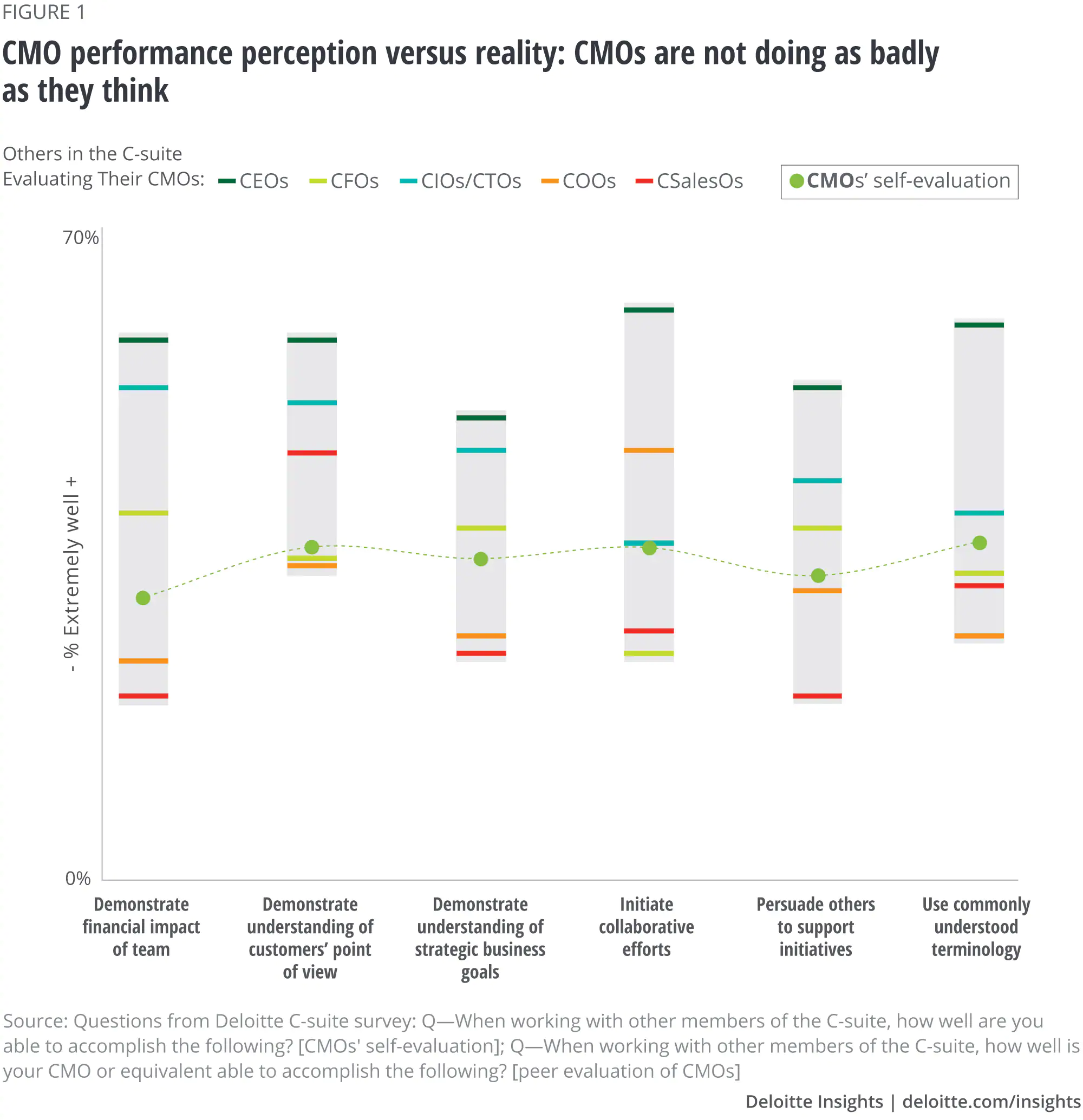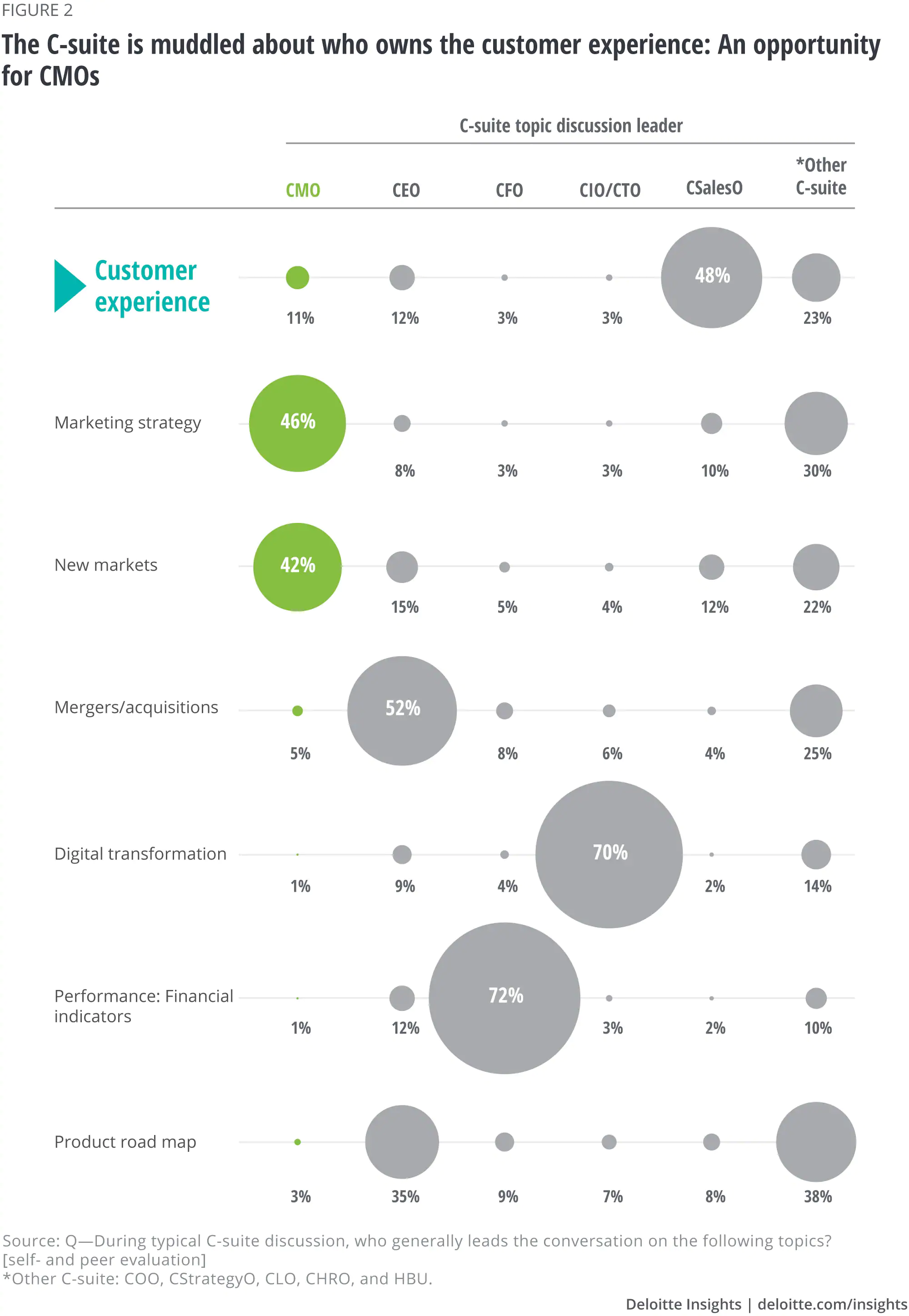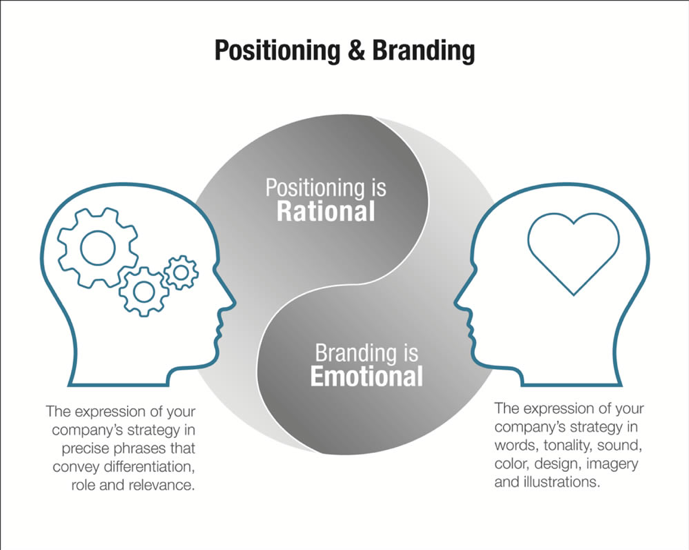
According to Deloitte Consulting, Many CMOs struggle to find a voice at the C-suite table. How can they elevate their influence and fully realize the role’s potential?
CMOs suffer from a crisis of confidence
CMOs are poised to wield considerable influence in the C-suite—and across their entire organizations. As digital technologies have changed the face of marketing—from creating innovative ways to connect with consumers to provide a wealth of customer data across every touchpoint—the role of the CMO has been significantly elevated.
Once largely responsible for brand and marketing campaign activity, CMOs today help drive customer experience and harness data-driven insights that can shape corporate strategy and impact financial performance. CEOs and other C-suite executives now expect CMOs to demonstrate how marketing drives growth and contribute to strategic business discussions. Yet, despite the elevation of the role and expectations of their C-suite peers, many CMOs face a crisis of confidence that is impairing their ability to fully engage with the C-suite and have a voice at the executive table, according to new Deloitte research.
The research, based on a survey and in-depth interviews with 575 Fortune 500 executives across the C-suite, examines how C-suite executives view CMOs’ contribution to corporate decision-making, why CMOs struggle to find their voice in the strategic conversations, and how they can achieve their place as enterprise-wide strategic leaders.
One of the most striking findings from the research is that CMOs are the least confident members of the C-suite—a harsh assessment they give themselves. Only 5 percent of CMOs in the study consider themselves high performers in their ability to impact strategic decision-making, contribute to the overall direction of the business, and garner support among their peers for their initiatives. Compare this with 55 percent of CEOs who consider themselves high performers. This lack of confidence may be more perception than reality, however. While CMOs’ self-reported assessment is quite low, most C-suite members think their CMO is performing at a higher level than they see themselves.


Based on the research, CMOs can consider three recommendations to help break the low confidence cycle and increase their influence in the C-suite:
1. Give yourself permission: CEOs give CMOs the highest marks for performance among all C-suite peers assessing the CMO. To boost their self-confidence, CMOs should give themselves permission to ask questions, get involved outside their traditional scope, and actively contribute to conversations with peers.
2. Lead the customer experience conversation: CMOs are not seen as leading the customer experience conversation; only 11 percent of C-suite executives perceive the CMO as leading the conversation, while 48 percent see the chief sales officer (CSO) in that role. CMOs should become the C-suite’s go-to person on customer experience, even if direct responsibility may lie in other areas of the organization.
3. Be the first to connect: CMOs are missing opportunities for cross-functional collaboration in the C-suite. Only 17 percent of C-suite execs report having collaborated with CMOs over the past 12 months, while 47 percent report having collaborated with COOs during this time period. CMOs can build confidence to speak up in the C-suite by connecting and collaborating with their C-suite peers.
These findings point to significant opportunities for CMOs to more clearly define their role as customer experience champion, forge closer relationships with other C-suite executives, and take more risks as leaders. Rather than waiting for others to define their role—or playing it safe sticking to familiar roles—CMOs should embrace the opportunity for growth and be brave about stepping into unfamiliar territory. By doing so, CMOs can gain more confidence and take their rightful place as strategic leaders in the C-suite.

Marketing and Sales Alignment with CMO GROW for Revenue Acceleration
Travel with me, if you will, back to 2008. It was a time, in the corporate world, when the sales team had all of the power and most of the fun. A company credit card in hand, they would organize meetings at conferences, trade shows, meetings on the golf course, or at their favorite hospitality event. Pleasantries were exchanged, orders were placed – and business kept rolling forward. Those were the good old days of yesteryear.
It is truly amazing how things change so quickly, and the landscape has been forever transformed. The business-to-business (B2B) sales process – once solely the domain of the million-miler set – has been joined, out of necessity, by the marketing team.
Yes, those guys (and gals) once known for coordinating trade shows, creating sales collateral and brushing up PowerPoint presentations, are now the integral part of a sales blueprint that requires a lot more than just sizzle -- and steak – to traverse and close a complex sales opportunity.
The New World
Today the lines between marketing and sales and have become increasingly blurred. It's difficult to really know within the sales cycle where the marketing role ends, and the sales role begins. The truth is that today marketing team is involved every step of the way if not in helping to close a deal, then its to inspect, understand and underwrite the customer journey. The need for alignment between sales and marketing has never been greater.
Because we live in a digital world, sales organizations need to be informed and trained on marketing programs and multichannel campaigns; and marketers need to clearly understand the sales cycle and customer journey, and to be able to identify and optimize each touch point along the sales continuum.
In fact, companies that have a firm grasp of how to cultivate leads in our brave new world generate 50 percent more sales than those still stuck in the go-go pre-recession days. And those B2B enterprises unable to align sales and marketing around the right programs, processes and technologies can bleed 10 percent – or more – of the cash off their bottom line!
Acceptance of the marketing team at the sales table, if not managed properly, can be a difficult proposition. Fortunately, seasoned, well-trained Chief Marketing Officer – like my colleagues at CMO GROW – has the ability to restore balance and order to your go-to-market ecosystem.
Alignment Redefined
It all starts with becoming aligned on the critical notion of how leads are found, cultivated and nurtured. We live in a world of
information symmetry. In fact, the majority of our B2B prospects have learned about what we sell – and how it will help them – before we have that first discussion.
This means that our digital presence – websites, content, drip marketing and social media channels – must be optimized for the challenge. This body of information ultimately represents the holistic narrative of why you’re relevant to today’s consumer. When done with skill, it can invoke the right emotional levers, at the right time, and in the right way that can lead to a closed/won deal.
Even though 88 percent of B2B marketers are currently employing some content marketing techniques, only 32 percent have formalized this strategic approach for the lead cultivation process.
This statistic reminds me of an alarming discussion I recently had with a company that complained of having a “sales” problem that has inhibited its ability to grow and expand in the way they had expected.
To this executive, the solution was to brute-force the challenge by hiring a senior sales person – someone with a Rolodex who
would hit the phones hard and book appointments. As our discussion progressed, it became evident to me that this executive had not considered the root cause of his “sales” problem. Though well-intentioned this executed had a hammer in his hand and was searching for any nail he could find to pound.
Funnel Creation
Marketing, it turns out, is best equipped to fill the top of today’s sales funnel. The rise of marketing automation has fueled the trend of “inbound marketing” – defined as the promotion of a company through blogs, podcasts, video, eBooks, newsletters, whitepapers and other forms of content. All of these channels give us the ability to both target the right type of influencer, and to then track their activity into, and through, our sales funnel.
It also means that marketing can and should be held accountable for a hefty portion of our overall sales success. In today’s realigned sales and marketing paradigm, nearly three-quarters of corporate marketers now have a quota for lead sourcing – and must track metrics like conversions, cost per acquisition and cost per closed account.
Closing the Deal
Much of the sales “top of funnel” responsibility has shifted from sales to the marketing team, there’s still plenty for the sales executive to accomplish. Their role, though shifted a bit, is still quite important in this ecosystem. Today’s sales managers should prepare and position themselves to be a trusted advisor – someone who facilitates the customer journey, ensuring that there company’s offerings are consistently delivering value to the relationship (and also considering areas to “upsell” the customer on new products that can further enhance the value proposition).
Though a recent study warns that by 2020, customers will manage 85 percent of their relationships without talking to a human, it’s critical that company's sales team reaffirms its value to be included in the 15 percent minority.
How is your company aligning its sales and marketing teams?

Neuroscience Forever Changing Marketing and Customer Acquisition
By Chris Lundell CEO at CMOGrow.com
Within an organization, functional groups like sales, marketing, operations, and finance, among others, need to adapt to the latest technology or they can quickly become an irrelevant bystander in their category and marketplace. Moreover, next to the IT department, no other group has experienced more technological innovation and change than the sales and marketing departments.
Progressive companies can, and do, leverage technology as a means to an end, for competitive differentiation and growth acceleration. More often than not, technology laggards find themselves standing on the street corner as their competitors and customers pass them by. With that said, these forward-thinking companies are leveraging new tools that include real-time data analytics, providing insights on how, where, and when, to iterate their campaigns, and by how many degrees. But if you thought that today’s wave of marketing analytics tools represented a bold new world enabling enterprise insights into customer response and buying cycles, then “hold onto your hat”, as the saying goes, because you ain’t seen nothing yet.
Remembering the movie, “Minority Report,” the show-cased technology blew people’s minds; it seemed farfetched and lightyears away. Today, the insights of advanced technology and innovative iterations are available to nearly every company and marketing manager across the globe. Access to these new-world tools, among other things, will provide real-time insights, data analytics, and access to customer feedback that you never dreamed possible.
With most customer acquisition campaigns, the associated outcome objective is to invoke a positive emotional reaction from the target consumer segment. These campaigns should extend from the company’s branding and messaging foundation, and when used correctly, should inform and enlighten their entire asset creation process. However, Google and Facebook are continually changing their process and algorithms, it is getting harder to reach target audiences, even if you are willing to spend marketing budget on paid ads, conversion success is becoming even more difficult.
So, what does that leave you with? Is marketing getting too complicated?
The truth is, the best option for companies is to increase their rigor and efforts around controlled split-testing and experimenting, to figure out how to best direct programs, campaigns, and activities. Today, through the use of technologies like electroencephalography (EEG), laser eye tracking, steady-state topography (SST) and galvanic skin response, marketers can gain real-time insights into whether their messaging is triggering an optimized response. And this is one example of how companies can successfully leverage technology to experience an enormous bang for the buck.
Used correctly, these tools have the potential to “forever change” the process used by managers to target their buying groups. Moreover, when you begin to factor ROI on spending into the equation, you will see key performance indicators (KPI) progress improve.
Undoubtedly, with better tracking and analytics, CMO’s will blow the top off of their KPIs and show real pipeline-to-conversion revenue growth. For many companies, one or two percent increase can represent millions of dollars in shareholder value.

As a longtime sales, marketing and neuroscience enthusiast, the marriage of these disciplines has been something that I have looked forward to for a long time. While traditional A/B testing, focus groups, and other methods will still have their place in the marketing medium execution stack, these new marketing breakthroughs will be the “new black” for progressive and forward-thinking sales and marketing groups.
The problem with traditional focus groups and split-testing processes is that it is a slow arduous and iterative process. Also, to make matters worse, most marketing managers find it difficult to resist the urge to manipulate two or more variables at the same time, making it impossible to know which variable provided the highest impact. Ultimately, it’s easy to show incremental improvement with this type of testing, but you never really know how much optimization you are leaving on the table, or how many dollars you are stepping over while picking up dimes. These new technologies will help to remediate this problem and compress the overall cycle time.
A while back, I visited the Vivint Smart Lab at Utah Valley University and witnessed first-hand how these break-through technologies are turbo-charging the ROI on their customers’ marketing dollars.
In one example, the test included a global 2000 company featuring a well-known celebrity who was endorsing the company’s solution offering. Towards the end of the video content, this female celebrity turned to the camera and folded her arms, bringing into light the giant diamond on her left-hand ring finger.
The bio-tools captured the information, and it became immediately apparent that the final scene hijacked the intent of the promotion, defocused the buying customer and in a sense, inoculated them from the call to action (CTA) offer.
When considering that the future of today’s executives and their respective careers and livelihoods are tied to the performance, conversion, and execution of their sales and marketing groups, you can see how these tools are quickly finding their place in corporate growth centers.
From the Chief Marketing and/or Chief Revenue Officer to the CFO and CEO, these tools will become invaluable to the building and fortification of the company’s growth engine efforts.
Chris Lundell is CEO and managing partner of the growth strategy consultancy CMO Grow. CMO Grow provides outsourced Sales and Marketing Executives for small and medium-sized companies.
Why Do Growth Companies Stop Growing? Can the CMO Restart Growth?
By Elizabeth Giuffrida, CMO at CMO Grow.com
I am a hopeless romantic. And “RomComs” are my absolute favorite film genre. I love the simplicity of the girl meets boy plot and the sentimentality of the protagonist’s rollercoaster ride to true love. Shakespeare once said, “The course of true love never did run smooth.”
Interestingly, the same could be said about business—I’m referring to the “run smooth” part, of course. Many if not most growth companies experience an inflection point—a significant change in the progress of the company, customarily a perceptible slowdown in growth. Similar to the romcom rollercoaster, this experience can be sickening, like a rollercoaster drop so steep that it makes a bungee jump seem like child’s play. There are myriad reasons that companies reach an inflection point—economic down-turn, changes in the competitive landscape, challenges with supply chain, failure to identify new opportunities, market saturation, losing their connection to the customer, lack of innovation, and many more.
So how do some companies prosper, while others struggle to keep the lights on? It comes down to a company’s ability to create a blueprint for success.
Take the blinders off! Don’t be the unsuspecting and complacent romcom protagonist, who is completely unaware of the impending conflict. Just because the sales team is hitting it out of the park this month, this quarter, or this year, doesn’t mean that the rest of the business is running smoothly. Similarly, a great NPS doesn’t mean that you can stop product innovation. Organizations that have a transparent and communicative process for reviewing metrics (aka key performance indicators or KPIs) can more easily identify areas of the business that could be susceptible to an inflection point. This candid self-analysis coupled with the honest answering of some tough questions can and will accelerate your company’s ability to see gaps in critical areas—namely, people, product, and process, and allow you the opportunity to pivot or in some cases execute an outright strategic transformation.
Questions you might ask:
• Do we have the right people in the right roles?
• Do we need to recruit new talent?
• Is our product still relevant or do we need to innovate?
• Do we need to augment our product line? Or sunset old products? Or both?
• Do we need expansion capital? Or did we expand too much? Or too quickly?
• Does our distribution model still work? Or do we need to develop new channel partners?
• Is our pricing still competitive?
• Do we need new systems to streamline operations?
If you don’t look at your business as a whole, you may risk your only opportunity to create and actualize a blueprint for success that propels you through inflection points. I’ve personally found this process of self-evaluation challenging for some companies, at least initially. This is especially true of newer companies with $5 or $10 million in sales, where the leadership team that built the company may not be the leadership team that can grow the company—at least not without some level of transformation.
Most companies reach their first inflection point at about $5 or $10 million in sales. The reason for this is that your people, product, and process don’t necessarily need to be dialed in for this level of success. However, to overcome and continue to grow past an inflection point, a company needs to make changes, it needs to transform—sometimes a little and sometimes a lot. But before you run off and start implementing a bunch of changes, perhaps you should take a step back and ask yourself if you’ve laid the groundwork necessary to restart growth.
Whether you have $10 million or $100 million in sales, if you’ve hit an inflection point, it may be time to revisit your position in the market or visit it for the first time in some cases. Positioning is different from branding and actually comes before branding. So, if you’ve branded your company without first going through the rigor of positioning, it’s likely that your brand is unconvincing and possibly inauthentic. Precisely identifying the position you own in the mind of your prospect is key to laying the groundwork required to create a blueprint for success. And comes down to two simple questions—"Who are you?” and “Why do you matter?”
If you cannot concisely answer these questions, then how are you going to convince people to buy your products and/or services over those of your competitors? Although challenging, answering these questions is essential to forming your company’s positioning statement … and a positioning statement is essential to cohesively align your entire organization around what your company stands for. Positioning is the “secret sauce.”

In our overcommunicated society your company and the products and services you offer need to own a position in the mind of your prospect, a position that is unique and authentic to you. Make no mistake, developing your positioning statement is no easy task and cannot be done in a vacuum, nor can it be the sole responsibility of your CMO or Marketing department. The key stakeholders of your company need to be engaged, starting with the CEO. The position you own in the mind of your prospect is a concept that needs to live and breathe throughout your company. Everyone needs to buy into it. And it needs to be at the core of decisions made at every level.
The Internet along with social media have created a level of transparency which limits, if not completely eliminates, a company’s ability to create an image that is not authentically theirs. For this reason, your positioning must reflect the real you—who you are and why you matter. Your positioning is then manifest in your brand, which is why positioning comes first. In essence, your brand is the emotional outward expression of your internal rational positioning (Figure 1). Once solidified, it will eliminate confusion about what your company stands for, enable you to streamline company-wide decision making around your people, product, and process, and optimize opportunities for growth—all of which enable you to create a blueprint for success.

Image by Andy Cunningham
So how do you prepare for future inflection points?
- Diligently measure and analyze key metrics to spot trends (good and bad) in your business and/or the market.
- Ask yourself tough questions about your people, product, and process.
- Be open to transformation, especially strategic transformation.
- Stay true to who you are and why you matter (positioning)—inauthentic perceptions don’t sell.
- Create a blueprint for success and be ready to implement it at every inflection point.
- Rinse. And repeat.
Much like the white-knuckled rollercoaster ride of a really good, albeit cheesy, rom-com, an organization's journey through an inflection point can conjure feelings of nausea. But once collaboratively navigated, a path for impending growth lay ahead.
Elizabeth Giuffrida is CMO and managing partner of the growth strategy consultancy, CMOGrow, a boutique agency focused on empowering companies with a robust sales and marketing blueprint for growth and performance.